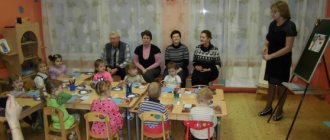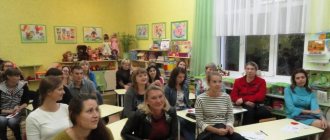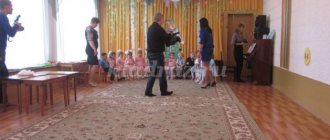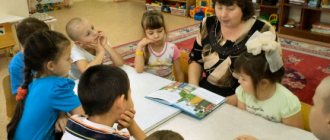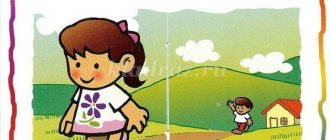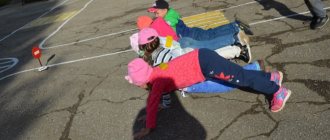Summary of an approximate lesson on familiarization with the outside world in junior groups of preschool educational institutions
Lesson on the topic “Family”
Goal: to form ideas about the family, to cultivate interest in names.
Additional material: family photo, glue and disposable plates according to the number of children in the group.
Games for the development and education of children 5 years old
Motivational part: Riddles about family, or a conversation about who is part of the children’s family (mom, dad, brother, sister, grandmothers, and others). The teacher involves all children in the lesson with leading questions. It is important to give each child a say or set up a small stand with photographs that the children from the group can see.
Content: Instead of a teacher, a fairy-tale character can ask questions: a soft toy or a doll. A problematic situation is posed, or a story is read that the character’s entire family has gathered at a large table for dinner and only one seat is left unoccupied. The question is asked why a family member is absent, who may be absent, for what reasons. Next, move on to the children's families. A conversation about what a family is and what traditions, besides evening dinner, the family has.
; Note! In this part of the lesson, you can use finger exercises (how mom cooked porridge, how dad worked, how grandma knitted, how brother rolled the car, and so on). Finger gymnastics can be diluted with general physical exercises and thus replace physical exercise.
During the lesson, talk to the children about the feelings that other family members experience when someone is not at home. A conclusion is required. In a fairy-tale character, someone must return to an empty place in order to clearly show the entire composition of the family.
Reflection: After the story, you can create a photo frame. Children glue the photo onto a plate and can put the frame in a visible place at home and share their impressions of the lesson. At the end, the children talk about their feelings and answer questions about what they remember, what a family is, what emotions they experienced when the character was missing one of the family members, how joyful the day was when the whole family was gathered.
Summary of the lesson on FCCM in the first junior group “In a forest clearing”
Goal: to teach children to draw a spring flower in an unconventional way.
Tasks:
• Continue learning to draw with a sponge on a piece of paper;
• Learning to draw flowers using the “dipping”
• develop imagination and perception of the surrounding world, develop fine motor skills;
• Consolidate knowledge of colors (yellow, red, blue);
• cultivate a caring attitude towards nature, form an emotionally positive attitude towards the drawing process itself.
Equipment and materials: Musical recordings (bird voices, murmur of a stream, buzzing of a bee), soft toy: Maya the bee, sponge, yellow gouache, flower meadow, pictures of dandelion
Preliminary work: reading books, memorizing poems, looking at paintings “Flowers in Spring”
, conversation about spring, observing changes in nature in spring, looking at insects.
Progress of the lesson:
Children sit around the teacher, a melody with the sounds of spring sounds.
Educator: Guys, let's listen to what beautiful music it sounds. What did you hear?
Children's answers.
Educator: What time of year do you think we can hear these sounds?
Children's answers.
Educator: That's right, we can hear all these sounds in the spring.
Educator: Guys, what happens in nature in the spring?
Children: Everything is waking up. With the arrival of spring, the sun began to shine brighter, it warms us very much.
Educator: At this time, insects appear. Do you know where they live (in the forest, in the city, in the park)
I invite you today to a forest clearing to visit insects.
Do you agree? Went!
Educator: We went out to the forest clearing, raising our legs higher.
Through bushes and hummocks, through branches and stumps.
Who walked so deftly without tripping or falling?
They approach the model of the clearing, covered with a green tablecloth with flowers.
Educator: Well, here we are! Look what a beautiful clearing! What do you see on it (flowers)
Name what color they are (red, yellow, blue, etc.) Let's sit down in the flower meadow, relax a little, admire the flowers.
Educator: Oh, children, do you hear? Who's buzzing?)…
Children: Bee.
Educator: Hello, bee!
Maya the Bee: Hello guys. My name is Maya the Bee! I got into trouble. Soon my bee friends will come to visit me; they really love flower nectar from dandelions. But I have nothing to treat them with, because there are still very few dandelions in our clearing. And I really want to collect a lot of nectar and treat my friends. Maybe you can help me?
- Children, where can we get dandelions?
- Yes, guys, I also think that we can draw dandelions.
But first let's play
PHYSMINUTE
Imagine that you are dandelions and growing in this clearing ( Children squat)
— Dandelions are starting to grow. Grow, grow - grown!
The wind blew and the dandelions swayed.
Evening has come, the dandelions are closing.
Morning has come - the dandelions have woken up and are nodding their heads.
Educator: Have you rested?! Now let’s all sit down at the table and look at the picture of a dandelion. What dandelion?
Children: Beautiful, yellow, round.
Educator: What are flowers for?
Children: To admire them.
—What does a dandelion flower look like? (in the sun, on the ball).
Educator: Today we will draw with a sponge.
“I’ll show you now how we’ll draw flowers using a sponge.” Dandelion, what color?
Children: Yellow.
— We dip the sponge in yellow paint, then “dip it in”
on the green grass. You get beautiful yellow dandelions.
The colors suddenly became like flowers, Lighting up everything around!
In the new yellow sundress Dandelion Meadow.
- Well done guys, you tried really hard
What wonderful flowers they turned out to be. Now let's place the dandelions together in our clearing - it turned out very beautiful. We will get a large dandelion meadow. - Guys, what do you think, is it possible to pick flowers just like that? Trample them underfoot? On green grass, yellow dandelions are very beautiful. Although there are a lot of them, you shouldn’t pick them.
Let's not pick dandelions and preserve beauty. And the bees will thank us for saving the flowers for them.
Oh, here our bee has arrived! That's how great!
-Bee: Oh, thank you, guys! Like there are many flowers in the meadow, I will now collect a lot of delicious nectar and treat it to my friends.
Subject:
"In a forest clearing"
Goal: to teach children to draw a spring flower in an unconventional way.
During the lesson it was expected to solve the following problems
Tasks:
• Continue learning to draw with a sponge on a piece of paper;
• Learning to draw flowers using the “dipping”
• develop imagination and perception of the surrounding world, develop fine motor skills;
• Strengthen knowledge of colors (yellow, red, blue);
• cultivate a caring attitude towards nature, form an emotionally positive attitude towards the drawing process itself
When developing this lesson summary, I first of all took into account the age and mental individual characteristics of the children of the first junior group.
Preliminary work was carried out with the children: reading books, memorizing poems, looking at the paintings “Flowers in Spring”
, conversation about spring, observing changes in nature in spring, looking at insects.
During the lesson, the children were active - they participated in the game and answered questions.
The children's interest remained throughout the lesson. The children were attentive
I believe that I was able to fully implement the assigned tasks.
Methodical techniques of the teacher
During classes to get acquainted with the outside world in the 2nd junior group, the following techniques are used:
- Verbal (story, conversation, dialogues, reading).
- Demonstration (display of illustrations, videos, presentations, study of natural objects and herbariums, excursions).
- Practical (experiments, games, performing any actions with objects and materials).
Work to familiarize yourself with the outside world
The game occupies a priority place in the teaching methods. It is through play that a child gains emotional experience and remembers faster. Story-based games based on fairy tales, farm and zoo games with domestic and wild animals, and learning the seasons with dolls give the child the opportunity not only to learn new things, but also to consolidate the acquired knowledge.
For example, by offering your child the game “Who Eats What,” you can get acquainted with wild and domestic animals, study forest animals, insects and birds, find out what edible and inedible plants and mushrooms are, and determine which plants grow fruits to feed different animals.
Mathematical quests for preparatory groups, KVN and puzzles
Games can be plot-role-playing, motor, creative, labor and didactic games of a natural history nature. Each activity can turn into a small journey and give your child the pleasure of learning new things.
Note! All classes in kindergarten are conducted in accordance with the requirements of the Federal State Educational Standard.
